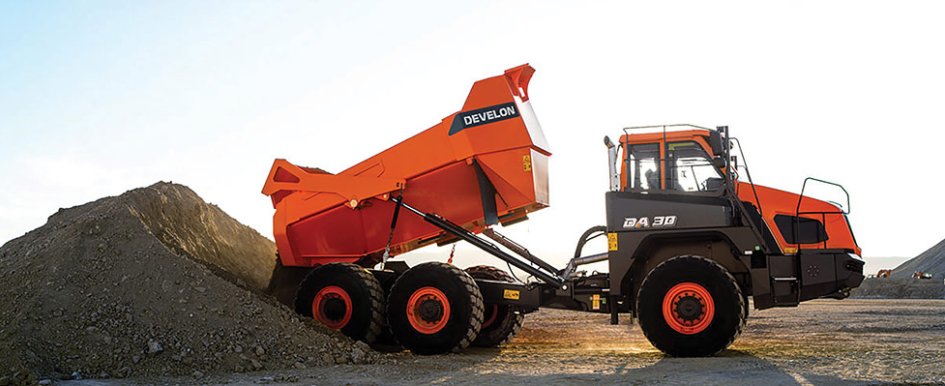
An excavator operator skillfully empties a bucket of dirt into the dump body of an articulated dump truck (ADT). After the payload is topped off, the truck takes off on a predetermined path. Upon arrival, the operator empties the material and returns for another load.
While this may seem unremarkable to some people, the work done by articulated dump trucks is critical to the success of construction projects. For more than 70 years, contractors around the world have relied on ADTs for efficient bulk material handling.
You may ask yourself why an ADT and not a traditional rigid-frame dump truck. Read on to discover three advantages of these machines.
Maneuverability
ADTs feature a unique articulated design that is significantly different from traditional rigid-frame dump trucks. The ADT frame is split into two parts connected by a pivot point. This allows the truck’s front and rear sections to articulate independently. As a result, ADTs have exceptional maneuvering capabilities for off-highway applications, particularly when working on uneven terrain.
Another feature of the truck’s articulated design is a tight turning radius. This allows operators to more easily work next to other construction equipment or existing structures on a jobsite.
Many ADTs available today are designed with all-wheel drive (AWD). The truck’s powerful engine generates the power, and the power is distributed to all wheels simultaneously — improving traction and stability, particularly on challenging terrain like wet and muddy jobsites. Some customers feel AWD is critical for maintaining control in adverse conditions, which are common in construction environments.
Another functional design feature of ADTs is a low center of gravity. Even when ADTs are fully loaded, they can traverse uneven ground while remaining stable. Manufacturers build ADTs to evenly distribute the weight (material) across the chassis, providing the necessary stability for operators moving from point A to point B.
Some ADT manufacturers offer a transmission retarder adjustment lever to help control speed and braking on steep surfaces and slopes. Many offer four levels of retarder force: 100%, 75%, 50% and 25%. As an alternative, a keypad button may serve the same function as the lever. A slight press of the ADT’s accelerator pedal can also quickly reduce retarder power.
Versatility
ADTs can move easily across a variety of surfaces, making them a popular choice for bulk material handling. Off-highway, they are especially functional for muddy construction jobsites, rocky quarries, waste processing facilities and sandy conditions.
When it comes to working with sand, a Florida contractor found success using ADTs to move the material during a beach repair project. After a hurricane damaged the beach, the contractor utilized multiple ADTs to transport sand and aid in restoring the beach. The trucks easily navigated across the sand, in contrast to conventional rigid-frame dump trucks which would have struggled with traction and stability.
Even for their large stature, ADTs have a relatively low ground pressure. The design minimizes pressure to the surfaces beneath them. This can prevent excessive soil compaction and help reduce the risk of damaging underground utilities.
Bill Stanton, vice president of operations at an organic processing center near Lakeland, Florida, relies heavily on ADTs for its daily operations, namely transporting materials. In addition to appreciating their versatility, he recommends the off-highway trucks from a serviceability standpoint.
“ADTs are well balanced for operating in this environment because the surface material tends to soften,” Stanton explained. “These trucks are very responsive, and they offer a lot of space around the mechanical components. Because working with this carbon material is volatile, it’s essential that we can easily clean the machines at the end of the day.”
For additional ease of maintenance, ADTs can be outfitted with an automatic lubrication system. The centralized system makes sure that the truck’s critical parts are properly lubricated at the correct intervals.
Stability
Jobsites often require trucks to drive across uneven terrain. ADTs excel in this situation because of their design. As an ADT moves across uneven terrain, each section of the truck can move independently to adjust to the contours of the surface. This feature helps the truck’s wheels maintain ground contact for enhanced stability.
Additionally, ADTs are typically designed with advanced suspension systems to absorb shocks and vibrations when traveling across bumpy terrain. The suspension system provides a stable ride when transporting material, as well as more comfort for the operator.
Some ADT manufacturers offer electronic control systems for additional stability. Even on uneven surfaces, the stability systems make sure the ADTs can safely be loaded. ADT operators can use the systems to monitor the truck’s wheel slip, tilt angle and steering input for optimal performance.
ADTs have proven to be the best solution for off-highway construction projects requiring bulk material handling. Today’s trucks incorporate additional performance, safety and operator comfort features. Visit a local dealer to learn more about ADTs for your next construction project.
Weighing Systems Enhance Efficiency
Articulated dump truck onboard weighing systems provide a variety of benefits to operators, including:
- Measuring the amount of material loaded into the truck accurately.
- Improving efficiency by reducing the trips required to move the necessary material.
- Minimizing fuel consumption and wear on the truck.
- Ensuring compliance with weight restrictions and preventing overloading, which can result in fines and damage to the truck.
- Enhancing safety by preventing overloads, which contributes to a safer work environment for operators and other personnel working in proximity to the truck.
It is always recommended that operators refer to the ADT operation and maintenance manual for the proper loading and unloading procedures for routine use.
